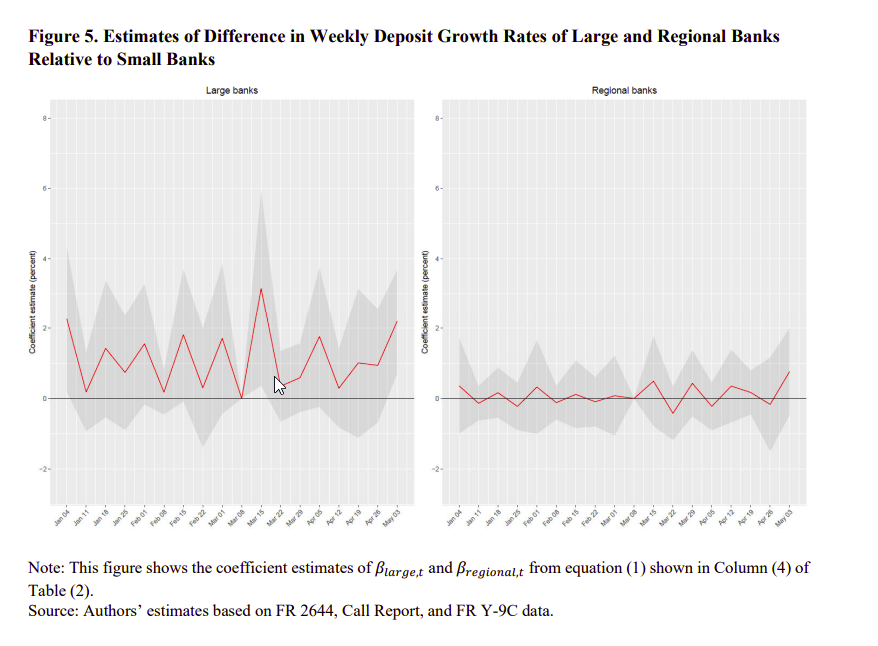This article provides insights into the behavior of depositors and the role of large banks during a banking crisis, offering valuable implications for policymakers, regulators, and researchers in the field of banking and finance.
Flight to Safety in the Regional Bank Crisis of 2023
- Caglio, Dlugosz and Rezende
- Working paper, 2023
- A version of this paper can be found here
- Want to read our summaries of academic finance papers? Check out our Academic Research Insight category
What are the Research Questions?
- What factors contribute to the deposit reallocation from small and regional banks to large banks during a banking crisis?
- Do large banks experience higher deposit growth rates compared to other banks during periods of heightened stress?
- Can changes in deposit growth rates at large banks be explained by bank characteristics associated with bank failures, such as the ratio of uninsured deposits and the liquidation value of banks?
- Do deposit interest rates play a role in explaining the deposit reallocation to large banks?
What are the Academic Insights?
By studying weekly confidential data from U.S. banks during the banking turmoil that began in March 2023, the authors find:
- A number of factors including:
- Perceived Safety-Large banks are perceived as safer by depositors during times of heightened stress. This perception may be due to several reasons, such as stricter regulatory and supervisory requirements imposed on large banks, their systemic importance, and the belief that deposits in these banks will be made whole even with government support.
- Flight to Safety-This behavior is driven by the exclusive characteristics of large banks that make depositors perceive them as safer options.
- Government Support Measures-Extraordinary actions taken by regulators and government support measures can influence deposit reallocation.
- YES – Deposits at large banks grew at a weekly rate roughly 2 to 3 percentage points higher than at small banks. This higher deposit growth rate for large banks is economically significant compared to the mean deposit growth rate.
- NO – They cannot be fully explained by bank characteristics associated with bank failures, such as the ratio of uninsured deposits and the liquidation value of banks. While these factors may play a role in understanding bank failures or predicting deposit losses, they do not account for the observed changes in deposit growth rates during the crisis.
- NO – Depositors’ decision to reallocate their deposits from small and regional banks to large banks during a crisis is not primarily driven by deposit interest rates. Other factors, such as the perceived safety and stability of large banks, seem to have a more significant influence on depositors’ behavior during a banking crisis
Why does this study matter?
This study is important because it contributes to the understanding of bank runs and the behavior of depositors during periods of heightened stress in the banking system. This understanding is crucial for policymakers and regulators to design effective measures to prevent or minimize the negative effects of bank runs. Additionally, it emphasizes the need for robust regulation and supervision of large banks due to their significance in maintaining stability and confidence in the banking system.
The Most Important Chart from the Paper:

Abstract
Using weekly confidential data from U.S. banks, we document an unprecedented flight to safety of deposits from regional banks towards large banks in the early 2023. We show that large banks experienced large deposit inflows relative to small and regional banks and that these differences remain substantial if we account for bank characteristics associated with bank failures over this crisis, including liquidation values and shares of uninsured deposits. Large banks lowered deposit rates relative to other banks during the crisis, supporting the hypothesis that deposits flew to these banks because they are considered safer.
About the Author: Elisabetta Basilico, PhD, CFA
—
Important Disclosures
For informational and educational purposes only and should not be construed as specific investment, accounting, legal, or tax advice. Certain information is deemed to be reliable, but its accuracy and completeness cannot be guaranteed. Third party information may become outdated or otherwise superseded without notice. Neither the Securities and Exchange Commission (SEC) nor any other federal or state agency has approved, determined the accuracy, or confirmed the adequacy of this article.
The views and opinions expressed herein are those of the author and do not necessarily reflect the views of Alpha Architect, its affiliates or its employees. Our full disclosures are available here. Definitions of common statistics used in our analysis are available here (towards the bottom).
Join thousands of other readers and subscribe to our blog.

